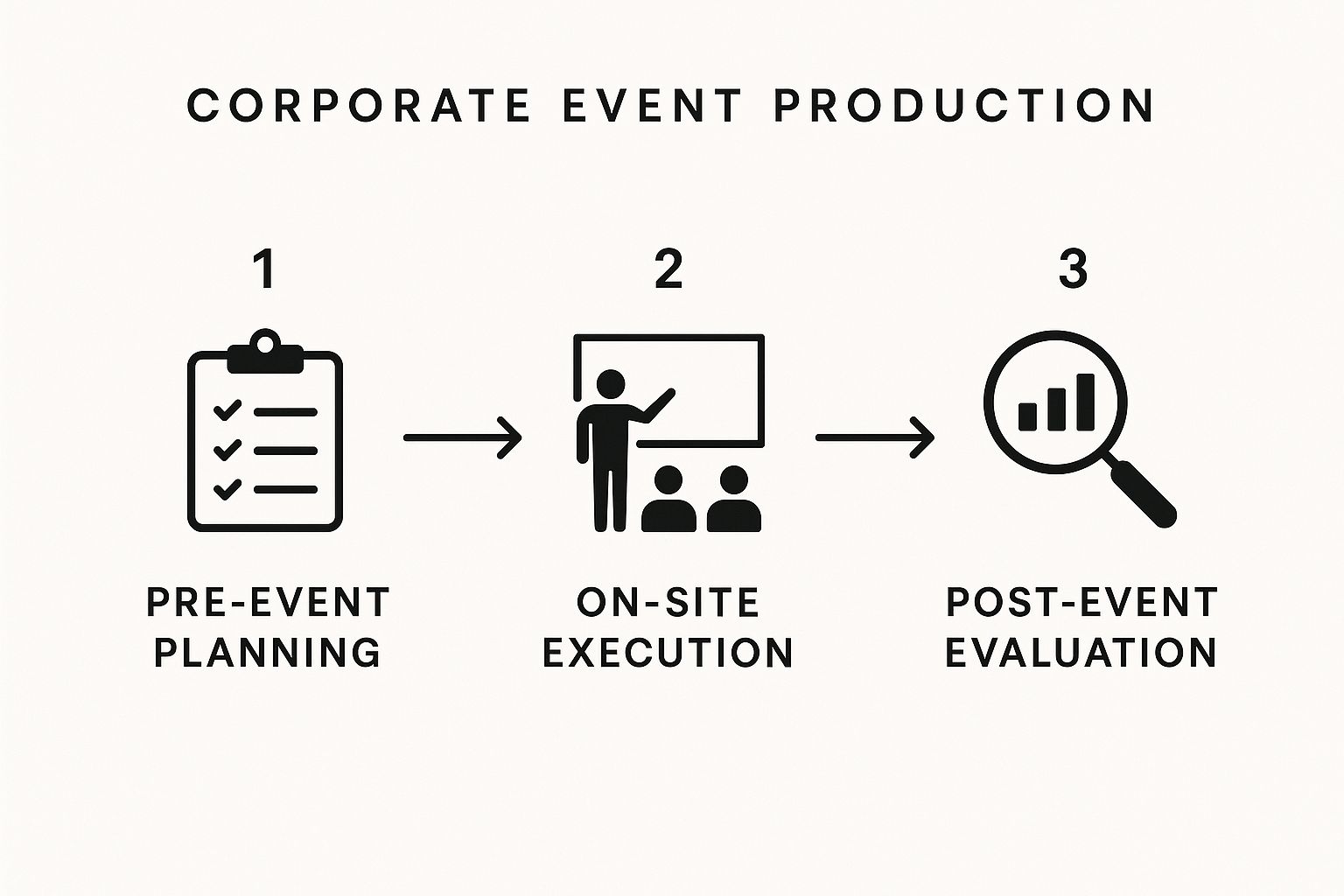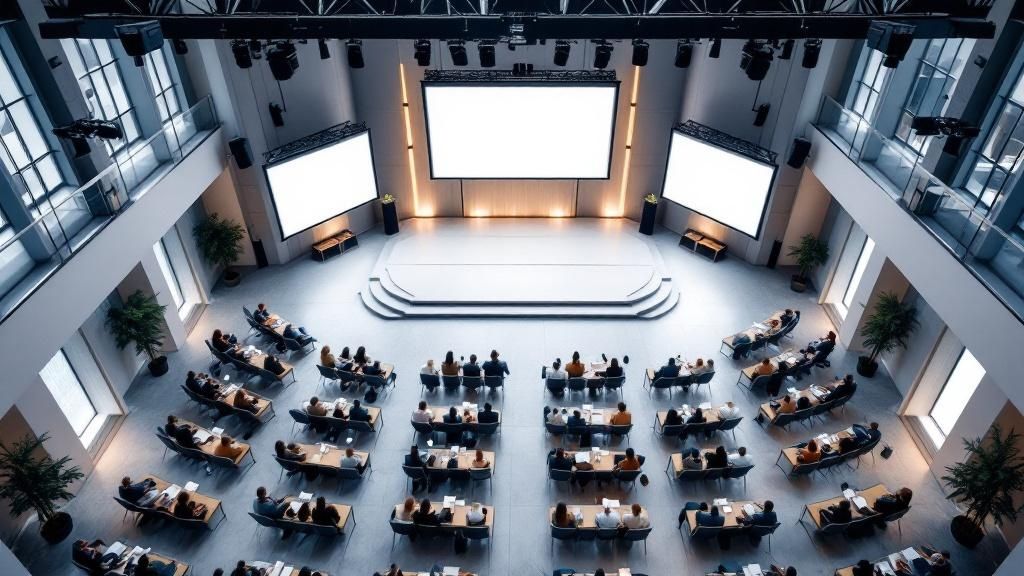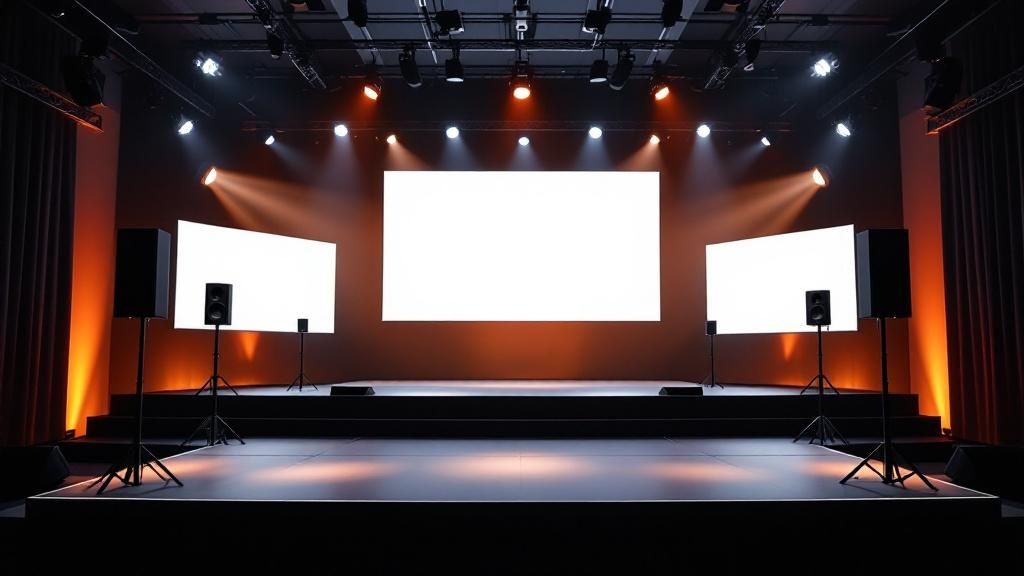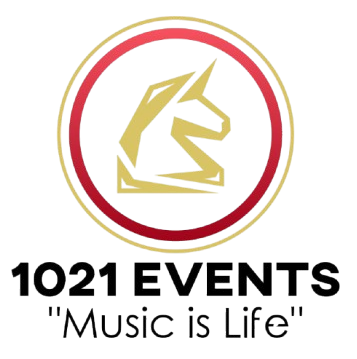Let's be honest, the days of stuffy galas and forgettable meetings are over. Today, corporate event production is all about creating experiences—moments that actually move your business forward. This isn't just about booking a room and ordering catering; it's the art and science of bringing a brand to life.
The Real Blueprint for Corporate Event Production
Think of your event as a powerful business asset, not just a party. The best event production is a disciplined process. It's how you design, plan, and pull off live, virtual, or hybrid events that hit very specific business goals. It digs so much deeper than just picking a venue and a menu.
At its core, great corporate event production is about understanding your "why." Why are you even gathering people in the first place? What do you want them to feel, think, or do when they leave? The answers to those questions will shape every single decision you make from here on out.
And businesses are catching on. The global corporate events market was valued at around $325 billion in 2023 and is on track to hit nearly $600 billion by 2029. That's not just pocket change; it shows how seriously companies are taking events as a real strategy for growth. You can dive deeper into this trend and what it means for event pros.
This simple infographic breaks down the three core phases that I've seen in every single successful event I've managed.

As you can see, it's a cycle. What you learn after the event wraps up should directly inform how you plan the next one.
To give you a clearer picture, here’s a quick breakdown of how these phases flow into one another.
Key Stages of Corporate Event Production
| Phase | Key Objective | Critical Tasks |
|---|---|---|
| Pre-Production | Establish a clear strategy and a solid plan. | Defining goals, setting the budget, choosing a venue, selecting vendors, developing a marketing plan. |
| Production | Execute the plan flawlessly on event day. | Managing logistics, coordinating with vendors and staff, overseeing AV and tech, ensuring a great attendee experience. |
| Post-Production | Measure success and gather insights for the future. | Collecting attendee feedback, analyzing data against KPIs, sending thank-yous, conducting a post-mortem review. |
This table maps out the journey, but the real work starts long before the first vendor is even called.
Laying the Foundation for Success
Before you get lost in the weeds of logistics, you have to get your foundation right. Nailing down your core 'why' and truly getting inside your audience's head are the first, non-negotiable steps. These early decisions will influence everything—the tech you use, the speakers you book, the overall vibe you create.
Here’s what you need to lock down first:
- Define Your "Why": Seriously, what's the point? Are you launching a product? Celebrating a huge win? Trying to get your remote team to actually connect? Your main goal sets the tone for the entire event.
- Know Your Audience: Who are these people? What do they care about? Understanding what makes them tick is the only way to design an experience that feels like it was made just for them.
- Set Measurable Goals: Forget vague hopes like "brand awareness." Get specific. Set hard Key Performance Indicators (KPIs) like "generate 150 qualified sales leads" or "achieve a 90% attendee satisfaction rating."
A well-defined foundation is your best defense against wasted money and effort. It ensures your event isn't just a day out of the office, but a calculated investment that delivers real, tangible value.
Getting these first steps right is everything. For a detailed, line-by-line guide to make sure you don't miss a thing, our comprehensive event planning checklist is an amazing resource to keep you on track. It’s the roadmap that shows you what a successful production really looks like and how to get there.
So, What's This Event Really For?

Every truly great event starts with a simple, powerful question: "Why are we doing this?" Before you even think about venues or catering, the most crucial part of corporate event production is nailing down what you actually want to accomplish. This is the bedrock of your strategy, the thing that separates a forgettable get-together from an event that truly moves the needle for your business.
Think of your core purpose as the ultimate filter for every decision you'll make. Are you trying to launch a new product and make a massive splash? Or maybe the real goal is to finally build some genuine connection among a remote team that only knows each other through a screen. Perhaps it's all about wooing high-value prospects and turning them into clients. Each of these "whys" demands a completely different kind of event.
A product launch needs buzz, media hype, and a serious wow factor. A team-building retreat, on the other hand, calls for activities that build trust and real camaraderie. A sales conference needs slick networking setups and a crystal-clear value proposition. If you skip this step, you’re just planning a generic party that doesn't really succeed at anything.
From Fuzzy Ideas to Rock-Solid Goals
Let's be honest, "We want to boost brand awareness" isn't a goal. It's a wish. To make your event a measurable success, you have to turn those vague notions into concrete, measurable objectives. This is how you prove its value and justify the spend later.
I always fall back on the SMART goal framework: Specific, Measurable, Achievable, Relevant, and Time-bound. It’s a classic for a reason. It forces you to get specific and define what a "win" actually looks like.
For instance, you could turn a fuzzy idea into a sharp objective like these:
- For Lead Generation: "Our goal is to generate 75 marketing-qualified leads from C-level execs by the close of our two-day conference."
- For Employee Engagement: "We're aiming for a 90% or higher satisfaction score on the post-event survey, specifically on questions about team connection."
- For Product Adoption: "We will secure 500 new trial sign-ups for our software during the live launch."
See the difference? Now your team has a clear target, and you've got the metrics you'll need to show a real return on investment.
Get Inside Your Audience's Head
Okay, you know your 'why.' Now it's time to figure out your 'who.' You simply can't design an amazing experience if you don't understand the people you're designing it for. What keeps them up at night? What gets them excited? What do they really want to get out of giving you their time?
Don't just guess. Create a few attendee personas. A "Sales Director" from a Fortune 500 company has entirely different needs and expectations than a "Junior Software Engineer" from a startup.
The best events feel like they were designed for an audience of one. That only happens when you stop planning for a faceless crowd and start planning for real people.
Try to imagine their day-to-day. Are they constantly in back-to-back meetings? A jam-packed agenda will just burn them out. Do they value networking above everything? Then you better build in plenty of structured and unstructured time for them to connect. This deep understanding will shape everything from the session topics to the kind of coffee you serve.
Bringing Your Concept to Life
With your purpose set and your audience in focus, you can finally start building an authentic event concept. This is the "big idea" or the central story that ties everything together.
A financial firm trying to build trust might go with a concept like "Navigating Your Future with Confidence," filled with expert panels and one-on-one financial clinics. A tech startup could build their launch around a "Playground of Innovation" theme, complete with interactive demos and gamified challenges. The concept has to feel true to your brand and directly support your main goal.
This is also the fun part where you can brainstorm some unique corporate event entertainment ideas that fit the theme, rather than feeling like a random add-on.
Your concept should be the golden thread running through everything:
- Event Branding: The name, logo, and overall look and feel.
- Content & Speakers: Every session should echo the main theme.
- Venue & Ambiance: The space itself should physically represent your concept.
- Activities & Flow: From networking breaks to workshops, it all needs to feel connected.
When you nail this, your event becomes more than a series of scheduled activities. It becomes a unified, powerful experience that sticks with your attendees long after they've gone home.
Getting a Handle on Your Budget and Vendor Squad

Alright, let's get into the two things that can truly make or break your event: your money and your partners. If you don't get these right from the start, you're setting yourself up for a world of hurt. A shaky budget will crumble, and the wrong vendors can completely torpedo even the most brilliant idea. This part of corporate event production is where your spreadsheet skills and your people skills have to work in perfect harmony.
Think of your budget as more than just a list of numbers—it’s the strategic roadmap for your entire event. It keeps your grand vision tethered to reality and forces you to make smart decisions. Flying blind without a detailed budget is a surefire way to end up overspent and overwhelmed.
Building an Event Budget That Actually Works
One of the biggest mistakes I see people make is only budgeting for the big-ticket items like the venue or the food. But the real budget killers are the sneaky little costs that pop up everywhere. A truly solid budget accounts for everything, and—this is crucial—it has a cushion for surprises.
The best way to start is by breaking everything down into categories. It just makes it so much easier to track and see where the money is really going.
- Venue Costs: The rental fee is just the beginning. Don't forget security, staffing, and any services they require you to use.
- Food & Beverage: Look beyond the per-person cost. Taxes and service charges can add a massive 18-25% to your bill.
- AV & Production: This includes all the gear (mics, lights, screens) and, just as importantly, the crew to run it all.
- Marketing & Promotion: Think digital ads, signage, and the fees for your registration software.
- Talent & Speakers: Their fee is one thing; their travel and hotel are another.
- The "Everything Else" Bucket: This is for permits, insurance, swag, decor, transportation… the list goes on.
If you remember one thing, make it this: the contingency fund. Seriously. Set aside at least 10-15% of your total budget for things you didn't see coming. This isn't a sign you planned poorly; it's a sign you're a pro.
To make sure you don't miss these details, grabbing a battle-tested template is a game-changer. You can use this comprehensive event budget template to get organized and keep an eye on every single dollar.
Finding and Choosing Your Dream Team of Vendors
Your vendors aren't just people you hire; they are your partners in pulling this whole thing off. The quality of your AV crew, your caterer, and your decorator directly shapes what your guests experience. Finding the right fit is about so much more than the cheapest quote. You're looking for collaborators who get your vision and are genuinely invested in making it happen.
Your first move should be asking for recommendations. Talk to people you trust in the industry or ask your venue coordinator who they love working with. Online directories are fine, but you have to back it up by doing your own homework. Once you’ve got a short list, it's time to start digging.
The Art of Vendor Negotiation and Management
Never, ever just accept the first proposal you receive. Any good vendor expects you to have questions and to negotiate. The goal isn't to squeeze every last penny out of them but to build a partnership where you both feel you're getting great value.
When you're ready to chat, here are a few questions I always ask:
- "Can you share a few references from events similar to mine?" Hearing directly from past clients is the best way to get the real story on how they operate.
- "What, exactly, is included in this price, and what isn't?" You need to know about any potential add-ons before you sign. I always ask specifically about labor, setup, and teardown fees.
- "Who will be my go-to person on event day?" You need to know who has the authority to make decisions when things are moving fast.
- "Can we walk through your standard contract?" Look closely at the cancellation policy, payment terms, and liability clauses. Don't be shy about asking for changes that make you more comfortable.
Once you've picked your team, your job switches from negotiator to relationship manager. Keep the lines of communication wide open. A vendor who feels like a respected part of the team is way more likely to jump in and save the day than one who feels like just another contractor. Treat them well, pay them on time, and they will become your most valuable assets.
Weaving in Tech and AV That Wows

Let's be real: in today's world, tech isn't just an add-on for your event—it's the central nervous system. Your audio, visual, and interactive elements are what turn a stuffy corporate meeting into an experience people actually remember. This is about so much more than just making sure the mic is on and the PowerPoint works.
At its core, great event tech starts with solid AV. The lighting sets the mood, the sound makes sure every word hits home, and the video tells your story. Getting these basics right is what separates the pros from the amateurs. I've seen it happen—a poorly lit stage makes a dynamic keynote speaker look exhausted, and a crackling mic can make a huge announcement totally missable.
Building the Core AV Experience
Before you even think about the flashy, cool gadgets, you have to nail the fundamentals. A rock-solid AV plan isn't about renting the most expensive gear; it's about designing an atmosphere that actually helps you hit your event's goals.
Start with the vibe. What do you want people to feel? If it's a high-energy sales kickoff, you'll want vibrant, moving lights and a sound system that can pump up the crowd with music. For a serious, data-driven conference, your focus needs to be on crystal-clear audio and crisp, easy-to-read screens.
Here are the non-negotiables I always insist on for a core AV setup:
- Professional Audio: Every single speaker gets a lapel or headset mic. No exceptions. This ensures consistent, clear sound from start to finish. You also need enough speakers to fill the space evenly—no dead zones in the back or deafening feedback for the front row.
- Strategic Lighting: Please, don't just flip on the house lights. Use uplighting to wash the walls in your brand colors. Use spotlights to make your speakers the undeniable center of attention. A proper stage wash is crucial so they look great, both for the live audience and for any cameras in the room.
- High-Definition Visuals: Whether you go for a massive LED wall or a few well-placed projector screens, make sure they're bright enough to cut through the stage lights and big enough for the folks in the cheap seats to see every detail.
Your AV crew is your most important partner on show day. Seriously. Don't just hand them a run-of-show and walk away. Walk them through your vision, point out the "can't-miss" moments, and treat them like the creative experts they are. A well-briefed crew can fix problems before you even know they exist.
Engaging Attendees with Modern Event Tech
Once you’ve got your foundational AV locked in, you can start layering in the fun stuff—the tech that turns passive attendees into active participants. This is where you create the "wow" moments that people will be buzzing about for weeks.
There's a reason event apps are everywhere now. They put the entire experience right in your attendees' hands with schedules, speaker bios, and networking features. The real magic, though, is using tech to get people involved during the sessions themselves.
Think about adding some of these engagement tools:
- Live Polling & Q&A: Platforms like Slido or Mentimeter let the audience vote in real-time or submit questions from their phones. It's a fantastic way to break up a long presentation and give everyone a voice, not just the person who's quickest to grab the mic.
- Seamless Registration: The attendee experience starts the second they walk in the door. A smooth, digital check-in with QR codes or tablets gets rid of those dreaded long lines and sets a polished, professional tone right away.
- Interactive Displays: Move beyond foam-core signs. Use touchscreens for interactive venue maps, digital agendas, or even fun games that reward people for exploring the space.
The Hybrid Challenge and the Rise of AI
Running an event for two different audiences—one in the room, one online—is easily one of the biggest hurdles in event production today. You can't just point a camera at the stage and call it a hybrid event production. It takes a completely separate strategy to make your virtual attendees feel just as included and valued as the people on site.
And of course, the tech itself is always changing. AI is quickly moving from a buzzword to a practical tool in our world. In fact, some research shows that about half of event professionals are planning to work AI into their events by 2025. They're looking at it to help with everything from smoothing out logistics to personalizing the attendee journey. It's a trend we all need to keep an eye on.
Game Day: On-Site Execution and Post-Event Wrap-Up
Alright, this is it. The moment of truth. After all the spreadsheets, late-night calls, and site visits, your event is finally here. All that strategic planning now gets put to the test, and your job shifts from architect to orchestra conductor. A smooth on-site experience is what truly defines professional corporate event production, and it's the part your attendees will remember long after they've gone home.
The secret to staying calm and in control on event day? Your run-of-show document. This isn't just a schedule; it's the minute-by-minute bible for your entire crew, from the AV team in the back to the greeters at the front door. It details everything—when the lights should dim for the opening keynote, when catering needs to top up the coffee, and the exact second the CEO is cued to walk on stage. This document is your single source of truth.
When you're in the thick of it, clear communication is everything. Team messaging apps are great for pre-event chatter, but on the day, nothing beats the reliability of old-school walkie-talkies or earpieces for your core production team. They give you instant, broadcast-style communication that doesn't depend on overloaded Wi-Fi, which is crucial for making those split-second decisions.
Navigating the Inevitable Hiccups
Let's be real: no event, no matter how perfectly planned, goes off without a hitch. A keynote speaker will get stuck in traffic, a projector bulb will decide to burn out ten minutes before a presentation, or a key piece of tech will just stop working. Your ability to handle these moments on the fly—without letting the audience sense a hint of panic—is what separates the pros from the amateurs.
The trick is having a crisis communication plan before you need one. Your team must know who makes the final call on different issues. For instance, a tech glitch goes straight to the AV lead, no questions asked. A catering problem? That’s for the venue liaison. This simple chain of command stops a dozen people from scrambling to fix the same problem, which only creates more chaos.
The goal isn't to prevent every single problem—that's impossible. The goal is to have the right people and processes in place so you can solve them so quickly and quietly that your attendees never even notice something went wrong.
This is where your contingency planning pays off. That extra cushion you built into your budget gives you the freedom to solve these issues without breaking a sweat. Need to rush-order a new cable or pay for a speaker's last-minute Uber? That’s exactly what your contingency fund is for.
Managing Attendee Experience and Flow
Beyond putting out fires, your most important on-site role is to be the guardian of the attendee experience. Put yourself in their shoes and walk the venue. Is the signage actually helpful? Are the check-in lines moving, or are people getting frustrated? Is the main ballroom freezing cold?
Keep a sharp eye on a few key areas:
- Registration and Check-in: This is your event's first impression. A quick, painless check-in with friendly, well-briefed staff sets a positive tone for the whole day.
- Session Transitions: Watch how crowds move between sessions. Are there bottlenecks in the hallways? Do people have enough time to hit the restroom, grab a coffee, and find their next seat without feeling like they're in a race?
- Networking Zones: Are people actually using the spaces you designed for networking? If an area is a ghost town, it could be too loud, tucked away in a weird corner, or just missing enough places to sit.
This kind of on-the-ground observation is priceless. It’s real, raw data showing you how people are actually interacting with the environment you created.
The Work Isn't Over When the Lights Go Out
Once the last guest has walked out the door and the teardown crew is packing up, the final—and most crucial—phase of your event kicks off. The post-event wrap-up is where you prove the event's value and set yourself up for future success. It's so tempting to skip this step in the rush to the next project, but trust me, it's a huge mistake.
First thing's first: get feedback while the experience is still fresh. Send out your post-event survey within 24 hours. Keep it short, focused, and make sure it looks great on a phone.
Ask direct questions that give you useful answers:
- On a scale of 1-10, how valuable was the content?
- Which speaker or session did you enjoy the most?
- How would you rate the networking opportunities?
- Was the venue easy to find your way around?
- What's one thing we could do to make next year's event even better?
This feedback is pure gold. It tells you exactly what hit the mark and what missed, giving you a clear roadmap for your next event. Finally, it’s time to circle back to those KPIs you set at the very beginning. Did you hit your sales lead target? Did you get the employee satisfaction score you were aiming for? Pull all this data into a solid post-event report to show your stakeholders a clear return on their investment.
Got Questions About Corporate Events? We've Got Answers
Even with the most detailed plan, you're going to have questions. It’s just the nature of putting on a great corporate event. Let's walk through some of the most common questions we hear from clients, whether they're planning their first event or their fiftieth.
How Far Out Should We Start Planning?
This is the classic "it depends" question, but I can give you some solid rules of thumb based on what we see every day. The timeline really hinges on the size and complexity of your event.
If you’re dreaming up a big conference or a gala for 500+ attendees, you need to give yourself 9-12 months. Seriously. That might sound like a lot, but it's crucial for getting the venue you want, booking high-profile speakers before their calendars fill up, and rolling out a marketing plan that actually builds momentum.
For something a bit smaller, like a regional sales meeting or a product launch for 100-500 guests, a 4-6 month window is usually comfortable. If you're just planning an internal workshop or a small get-together for under 100 people, you can often pull it off beautifully in 2-3 months.
The real make-or-break factor? Your venue. The best spots get snatched up more than a year in advance. If you have your heart set on a specific place, lock it down first, even before you have all the other details ironed out.
What Are the Biggest Hidden Costs We Should Watch Out For?
If there's one budget line item that trips people up time and time again, it's audiovisual (AV) and tech. It's the king of hidden costs.
Many venues will tell you they have an "in-house" AV package, but buyer beware. These basic setups are often just that—basic. They might not have the professional-grade microphones, dynamic lighting, or sharp projectors you need to create a truly polished experience. And don't even get me started on dedicated, high-speed Wi-Fi. Those upgrades can make your budget swell surprisingly fast.
Beyond the tech, here are a few other costs that often fly under the radar:
- People Power: You need to account for everyone from security guards and registration staff to A/V techs and coat check attendants.
- Spreading the Word: The cost of digital ads, printed signs, and the fees for your registration platform all need a place in your budget.
- The "Just-in-Case" Fund: This isn't really a cost, but it's non-negotiable. Set aside 10-15% of your total budget as a contingency fund. You'll be glad you did when those inevitable last-minute needs pop up.
How Do I Actually Measure Event ROI?
Figuring out your return on investment all goes back to the goals you set at the very beginning. Your ROI calculation isn't some generic formula; it has to be tied directly to what you wanted to achieve in the first place.
Was your goal to generate leads? Then you need to track how many qualified leads you captured and, more importantly, how many of them converted into customers in the following months. If you were aiming for brand awareness, look at things like social media mentions, press hits, and website traffic during and immediately after your event.
For an internal event focused on employee training or morale, post-event surveys are your best friend. They can help you measure knowledge retention, employee satisfaction, and how connected your team feels.
A simple formula to get you started is:
(Total Event Value – Total Event Cost) / Total Event Cost = ROI
Just remember that "Event Value" isn't only about hard sales. It also includes the value of things like stronger client relationships or boosted team morale.
Should I Just Hire a Professional Event Company?
For anything more complex than a small, casual meeting in your own office, hiring a professional event production company is one of the smartest moves you can make. Yes, it's an upfront cost, but the value you get is almost always worth it.
Think about it: they live and breathe this stuff. They have deep industry knowledge and long-standing relationships with vendors, which can often get you better pricing than you could ever find on your own. They know what can go wrong and how to fix it before it becomes a disaster. This is especially true in the nonprofit world, where every dollar has to count; we actually dive deeper into this in our guide on nonprofit event planning.
When you bring in a pro team, they handle the mind-numbing logistics, the technical headaches, and the vendor wrangling. This frees you and your team up to focus on what really matters: your content and connecting with your guests. For a high-stakes event, that peace of mind is priceless.
Ready to put on an event that people will be talking about for all the right reasons? The team at 1021 Events has the know-how and the gear to make it happen. From crystal-clear sound and lighting to jaw-dropping visuals, we craft experiences that stick. Let's start planning something extraordinary. https://www.1021events.com

